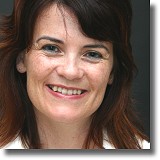It's been a while since I posted here.
In case you're wondering, all the goings-on in my wordy life - poeming, publishing and phd-ing - are readable over on my websites here and here, which is why this little corner has been so quiet!
Tuesday, May 8. 2012
How laughter and playfulness are the keys to our creativity
Earlier today I watched Mr Funnyman himself, John Cleese, give a lecture about creativity. I found the video over here at the most excellent 'Brain Pickings' website.
He talked about how people operate in one of two modes: 'open' or 'closed'. These loosely align with 'right' and 'left' brain.
In 'closed' mode - and this is the mode we're in most of the time - we are purposeful and anxious, thinking about how much we have to do; we may be impatient and tense and we're definitely not feeling playful. In this state, says Cleese, it is impossible to be creative.
When we're in 'open' mode, however, we are less purposeful, more contemplative, playful and curious - and this is the state which gets our creative beans jumping.
According to Cleese (and he was rather un-Monty-Python-esque about it all until the end, although he did share plenty of lightbulb jokes), it's important to set aside a regular time and space to be playful and thoughtful so that we can reach our creative selves.
He expands on this and talks about how organisations are stifling creativity by creating environments without playfulness, but with plenty of solemnity and rigour, around processes and systems. In fact the two modes are complementary and essential to each other: when we're in 'open' mode, we are more likely to work out how to solve a problem. When we revert to 'closed' mode, we can then implement the solution efficiently.
Much of his talk could be summarised by this pithy quote from the wonderful Alan Watts:
So pop over and watch Basil Fawlty share serious - but not solemn - thoughts about creativity.
Let's remember to laugh, play, and have fun with our creative selves.
He talked about how people operate in one of two modes: 'open' or 'closed'. These loosely align with 'right' and 'left' brain.
In 'closed' mode - and this is the mode we're in most of the time - we are purposeful and anxious, thinking about how much we have to do; we may be impatient and tense and we're definitely not feeling playful. In this state, says Cleese, it is impossible to be creative.
When we're in 'open' mode, however, we are less purposeful, more contemplative, playful and curious - and this is the state which gets our creative beans jumping.
According to Cleese (and he was rather un-Monty-Python-esque about it all until the end, although he did share plenty of lightbulb jokes), it's important to set aside a regular time and space to be playful and thoughtful so that we can reach our creative selves.
He expands on this and talks about how organisations are stifling creativity by creating environments without playfulness, but with plenty of solemnity and rigour, around processes and systems. In fact the two modes are complementary and essential to each other: when we're in 'open' mode, we are more likely to work out how to solve a problem. When we revert to 'closed' mode, we can then implement the solution efficiently.
Much of his talk could be summarised by this pithy quote from the wonderful Alan Watts:
You can't be spontaneous within reason.
So pop over and watch Basil Fawlty share serious - but not solemn - thoughts about creativity.
Let's remember to laugh, play, and have fun with our creative selves.
Posted by Jennifer Liston
in Compelling words, Creativity, John Cleese, Marketing & communications, Powerful language
at
05:33
| 1 Comment
| No Trackbacks
(Page 1 of 1, totaling 2 entries)

